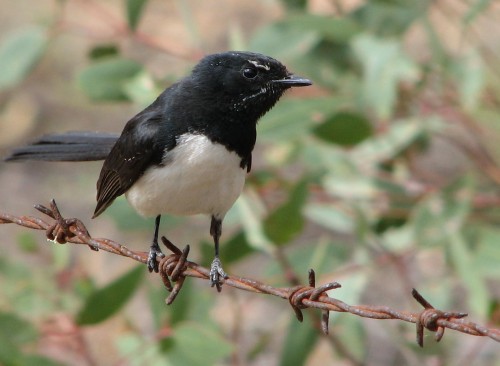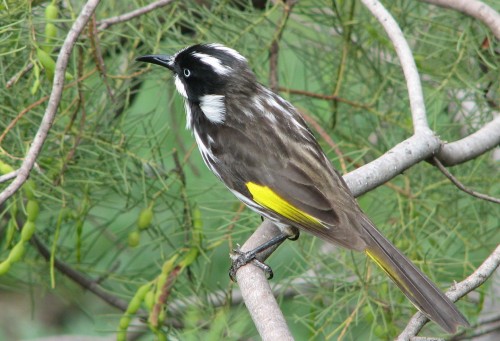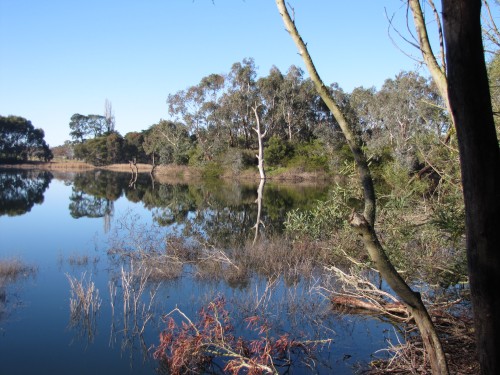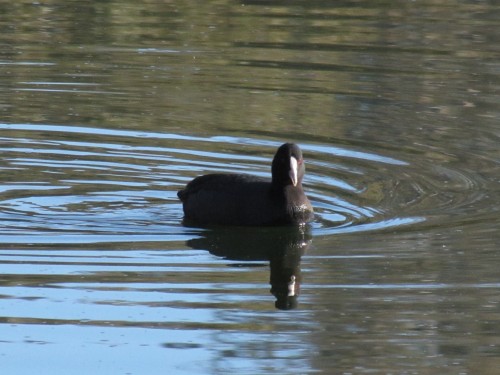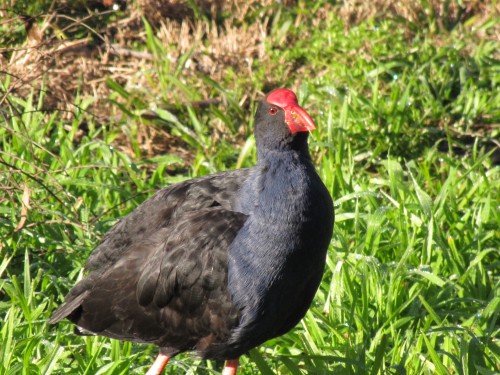Great Birding Moments #9 Brown-headed Honeyeaters
We have quite a range of honeyeaters resident in our garden. One of the more endearing species is the smallest of them all, the Brown-headed Honeyeater. This species is usually seen in loose flocks of 12-20 or more. I enjoy hearing their chittering calls as they pass through the garden or the mallee scrub at the back of our house. They seem to be always on the move, rarely settling for more than a few moments.
One exception to this is when they come to the birdbath for a drink or a communal bathing session. We have often been amused as they all line up on a nearby branch, all waiting to take a turn at bathing. Water droplets spray in all directions.
A few days ago I counted at least 18 of them all lined up on the gutter on the roof of the cabin near the house. This time they weren’t politely waiting for their turn to bathe. They all seemed to want a bath at the same time. Again, water droplets sprayed in all directions.
Here is my dilemma: leave the gutter/bath as it is – or should I clean it out thus denying them of this delightful fun?
Great Birding Moments #6 New Holland Honeyeaters
We have many flowering trees and bushes in our garden on the outskirts of Murray Bridge in South Australia. As a result of all these plants there is a steady supply of food for many species of birds, especially a range of honeyeaters. Over the last 22 years we have recorded the following species of honeyeaters:
- Red Wattlebirds – resident, breeding, very common.
- White Plumed Honeyeaters – resident, breeding, very common.
- Spiny Cheeked Honeyeater – resident, breeding with only several present at any one time.
- Brown Headed Honeyeater – regular visitor, breeding and usually in groups of 8-12.
- Noisy Miner – only one doubtful record many years ago despite being common along the River Murray less than 5km away.
- Striped Honeyeater – occasional visitor, recorded breeding only once which remains probably the most south-westerly record of breeding in Australia.
- White Eared Honeyeater – occasional visitor despite being widespread in this area.
- Yellow Plumed Honeyeater – occasional visitor.
- New Holland Honeyeater – resident, breeding and very common.
- Singing Honeyeater – resident, breeding and common.
New Holland Honeyeaters
The most prominent species has to be the the New Holland Honeyeater. This was not always the case. When we moved here we never saw any New Hollands despite being very common throughout Murray Bridge and the district. After the first few migrated to our garden, the numbers increased rapidly until they are now the dominant species. They are also rather aggressive. (See my posting called “Aggressive bird behaviour in the garden.”)
Distribution and Habitat
New Holland Honeyeaters are widely distributed along coastal south-eastern Australia. They are also found in southern Western Australia and in Tasmania. They prefer gardens, parks, golf courses, orchards, mallee, heathlands, coastal scrubs and eucalypt woodlands. They are often found in association with other honeyeater species towards which it acts aggressively, chasing them away from their preferred flowering plants.
Photo opportunities
I have had many opportunities to photograph this species over the last year. The best is the one featured at the top of this post. I was near the neighbour’s fence looking at the old plough set as a garden ornament. The bird alighted on the handle only three metres away and settled long enough for me to zoom in, focus and shoot. I am very pleased with the result; it couldn’t have posed better if I’d given it instructions.
The photo below is of another bird, and yes, it is up the right way. It’s the bird that’s upside down!
Aggressive Bird Behaviour in the Garden
While working in the garden yesterday morning I was suddenly alerted to a noisy confrontation nearby. Our resident Willie Wagtails love to frequent one particular spot where there is an abundance of insects.
Suddenly a New Holland Honeyeater dived in to reap his share of the smorgasbord. The Willie Wagtail became quite aggressive, fanning his tail up high, ruffling the feathers all over and calling in what seemed to me to be in quite an angry – perhaps even distressed – way.
The honeyeater retreated to a nearby tree, only to swoop in repeatedly over the next few minutes. Each time the honeyeater would snap at the Willie Wagtail, zip away a metre or so, grab another insect, and retreat hurriedly to the refuge tree.
These attacks seemed to trigger even more aggression in the Willie Wagtail who decided to front up to the interloper. They then faced each other at about ten paces (bird step size – about 10cm) angrily calling in each others’ face. One last beakful of food and the New Holland Honeyeater decided that other parts of the garden were more attractive anyway, and it flew off. The Willie Wagtail continued to feast contentedly on his little patch.
Further reading:
- Aggressive birds – articles from my archives
This post updated in September 2015.
Australian Shoveler at Clare, South Australia
On Sunday I went for a short walk from my daughter’s home in Clare. At the end of a nearby street I came to an open area surrounding the local sewage treatment plant. I used to visit this area from time to time when we lived in Clare about 25 years ago. I had not visited the area again since.
Sewage Treatment Plant
Sewage treatment plants are very interesting places. They tend to attract quite a variety of birds. These, in turn, attract birders like me. On this occasion I was not disappointed. There were the usual suspects like Masked Lapwings along the edges, Pacific Black Ducks, Grey and Chestnut Teal and several Australasian Grebes. I was not surprised to see about twenty Pink Eared Ducks as well because I have often seen this species on Inchquin Lake a few hundred metres away. I was delighted to see about a dozen Black Swans as I can’t recall having seen them on the lake. Perhaps the lake, with its nearby picnic area on one side and golf course on the other, is too populated and noisy.
Australian Shoveler
One species I hoped to see was the Australian Shoveler. I had not observed this species of duck for over twenty years and only on a handful of occasions at that. I have only ever seen it on one occasion elsewhere so I was very pleased to record it again here. In the past I can only recall seeing up to about five individuals. This time there must have been over thirty present. It made me wonder if this species is a regular visitor, or is it actually a breeding resident species. I must remember to check it out more regularly as I visit my daughter.
Other birds seen
Other birds heard or seen nearby include Australian Magpie, Magpie-lark, Musk Lorikeet, Galah, Crimson Rosella, Willie Wagtail, Noisy Miner, Red Wattlebird, White Plumed Honeyeater and New Holland Honeyeater. On the nearby Inchquin Lake I observed Blue Billed Ducks, Wood Ducks and four Black Fronted Dotterels.



